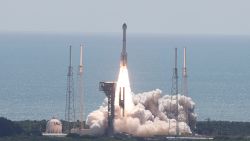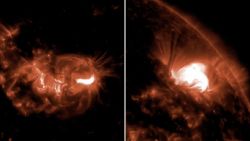Editor’s Note: Don Lincoln is a senior scientist at the Fermi National Accelerator Laboratory. He is the author of several science books for general audiences, including the bestselling audio book “The Theory of Everything: The Quest to Explain All Reality.” He also produces a series of science education videos. Follow him on Facebook. The opinions expressed in this commentary are solely his. View more opinion articles on CNN.
The moon is one of my favorite celestial bodies, beautiful and alluring – close enough for astronauts to have visited and studied, and yet distant enough to still hold many mysteries. And those mysteries are not just poetical metaphor; a recent scientific article published in the journal Geophysical Research Letters claims that scientists have discovered a huge and unexpected mass buried deep underneath the moon’s surface.
Peter B. James, lead author of the article and assistant professor of planetary geophysics in Baylor’s College of Arts & Sciences, explained his team’s discovery in a Baylor University release.

This mass is enormous – equivalent to a chunk of metal over five times larger than the Big Island of Hawaii, James said. And it is located under the moon’s South Pole-Aitken basin, a huge crater located on the far side of the moon.
At a big-picture level, the discovery of such a large and unexpected feature on the surface of the moon reminds us that we have so much to learn about the birth of the Solar System.
Although scientists have measured the South Pole-Aitken crater to be as much as 2,000 kilometers (1,200 miles) wide and several kilometers deep, it is not visible from Earth.
The newly-discovered feature has a minimum mass of over two quintillion (2 x 10^18) kilograms – or 4.8 quintillion pounds on Earth – and it is located as much as 300 kilometers under the surface of the moon.
This new feature was discovered by scientists combining precise topographical data from the Lunar Reconnaissance Orbiter (LRO) and gravity measurements from the Gravity Recovery and Interior Laboratory (GRAIL) spacecraft. Data from the two revealed that the area under South Pole-Aitken basin experiences stronger gravity due to the extra mass, and also the sheer weight of the mass pulls the crater floor down by more than a kilometer (half a mile).
In spite of sounding like the beginning of a summer blockbuster movie, the scientists who made the discovery don’t believe that the new lunar feature is an alien base containing troops and craft that are waiting for an opportune moment to invade the Earth. (Although I hope Will Smith and Jeff Goldblum have cleared their calendars, just in case the science community is wrong.)
Instead, James’ team thinks that the extra mass most likely comes from a primordial impact to the moon, over 4 billion years ago. This hypothesis is perfectly reasonable. The early solar system was full of debris, ranging from the size of pebbles to small planets. In fact, the moon is thought to have been formed about 4.5 billion years ago, when an object the size of the planet Mars hit the Earth. This impact threw up debris that both crashed back to the Earth’s surface and also formed a disk of orbiting debris that eventually coalesced into the moon.
The most reasonable explanation, as the scientists found, for the high mass anomaly under the South Pole-Aitken basin is that after the moon stabilized shortly after its formation, a large asteroid hit the lunar surface at relatively low speed and at a nearly grazing angle. This hypothesis can explain some of the long-known features of the lunar topography surrounding the impact crater and also the location of the discovered mass compared to the crater’s center.
While the impact hypothesis is probably more likely, James’ team left room for another possibility: the mass could be the result of how dense oxides crystalized in the moon’s crust during the later stages of when the moon’s magma solidified. It will take additional study to definitively decide the origin of the newly-discovered anomaly.
Although we understand the broadest of strokes, it is only through careful study of other members of our planetary family that we’ll fill in the details. It is highly likely that additional study will reveal other fossil remnants of ancient astronomical collisions.
And if it turns out that Hollywood was right all along, and we’ve finally found the hidden alien base, I volunteer for the mission. NASA… you know where to find me.






















